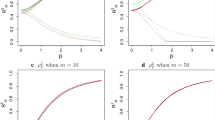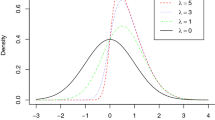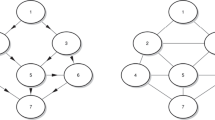Abstract
The measurement error model is a well established statistical method for regression problems in medical sciences, although rarely used in ecological studies. While the situations in which it is appropriate may be less common in ecology, there are instances in which there may be benefits in its use for prediction and estimation of parameters of interest. We have chosen to explore this topic using a conditional independence model in a Bayesian framework using a Gibbs sampler, as this gives a great deal of flexibility, allowing us to analyse a number of different models without losing generality. Using simulations and two examples, we show how the conditional independence model can be used in ecology, and when it is appropriate.
Similar content being viewed by others
References
Adcock RJ (1877) Annote on the method of least squares. Analyst 4: 183–184
Adcock RJ (1878) A problem in least squares. Analyst 5: 53–54
Austin MP, Meyers JA (1996) Current approaches to modelling the environmental niche of eucalypts—implications for management of forest biodiversity. For Ecol Manag 85: 95–106
Bashir SA, Duffy SW (1997) The correction of risk estimates for measurement error. Ann Epidemiol 7: 154–164
Beamish RJ, McFarlane GA (1983) The forgotten requirement for age validation in fisheries biology. Trans Am Fish Soc 112(6): 735–743
Berkson J (1950) Are there two regressions?. J Amer Stat Assoc 45: 164–180
Campana SE (2001) Accuracy, precision and quality control in age determination, including a review of the use and abuse of age validation methods. J Fish Biol 59: 197–242
Carroll RJ, Ruppert D, Stefanski LA (1995) Measurement error in nonlinear models. Chapman and Hall, New York
Cheng CL, Ness JWV (1999) Statistical regression with measurement error. Kendall’s Library of Statistics, Arnold
Clayton DG (1992) Models for the analysis of cohort and case-control studies with inaccurately measured exposures. In: Statistical models for longitudinal studies of health
Dellaportas P, Stephens DA (1995) Bayesian analysis of errors–in–variables regression models. Biometrics 51: 1085–1095
Fernandes R, Leblanc SG (2005) Parametric (modified least squares) and non-parametric (Theil-Sen) linear regressions for predicting biophysical parameters in the presence of measurement errors. Remote Sens Environ 95(3): 303–316
Fuller WA (1987) Measurement error models. Wiley series in probability and mathematical statistics. Applied probability and statistics. Wiley, New York
Gelman A, Rubin DB (1992) Inference from iterative simulation using multiple sequences. Stat Sci 7(4): 457–511
Gustafson P (2003) Measurement error and misclassification in statistics and epidemology: impacts and Bayesian adjustments. Chapman & Hall/CRC, London
Hutchinson MF, Nix HA, Houlder DJ, McMahon PJ (1998) ANUCLIM version 1.6 user guide. Centre for resource and environmental studies. The Australian National University, Canberra
Kuha J (1997) Estimation by data augmentation in regression models with continuous and discrete covariates measured with error. Stat Med 16: 189–202
Mallick BK, Gelfand AE (1996) Semiparametric errors-in-variables models. A Bayesian approach. J Stat Plann Infer 52: 307–321
Müller P, Roeder K (1997) A Bayesian semiparametric model for case-control studies with errors in variables. Biometrika 84: 523–537
Phillips AN, Smith GD (1992) Bias in relative odds estimation owing to imprecise measurement of correlated exposures. Stat Med 11: 953–961
Richardson S, Gilks WR (1993) A Bayesian approach to measurement error problems in epidemiology using conditional independence models. Am J Epidemiol 138(6): 430–442
Richardson S, Gilks WR (1993) Conditional independence models for epidemiological studies with covariate measurement error. Stat Med 12: 1703–1722
Spiegelhalter D, Thomas A, Best NG (1996) BUGS: Bayesian inference using Gibbs sampling. Medical Research Council Biostatistics Unit, Cambridge
Williams K, Norman P, Mengersen K (2000) Predicting the natural occurence of blackbutt and gympie messmate in southeast queensland. Aust For 63(3): 199–210
Yuan LL (2007) Effects of measurement error on inferences of environmental conditions. J N Am Benthol Soc 26(1): 152–163
Author information
Authors and Affiliations
Corresponding author
Rights and permissions
About this article
Cite this article
Denham, R.J., Falk, M.G. & Mengersen, K.L. The Bayesian conditional independence model for measurement error: applications in ecology. Environ Ecol Stat 18, 239–255 (2011). https://doi.org/10.1007/s10651-009-0130-3
Received:
Revised:
Published:
Issue Date:
DOI: https://doi.org/10.1007/s10651-009-0130-3




